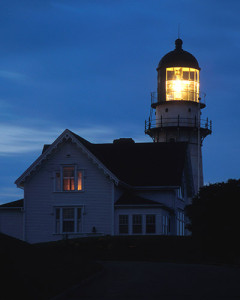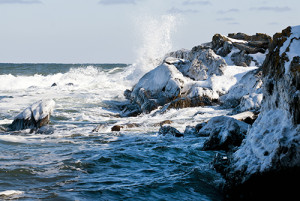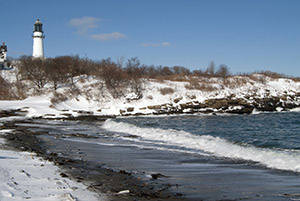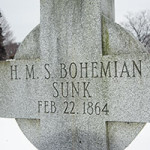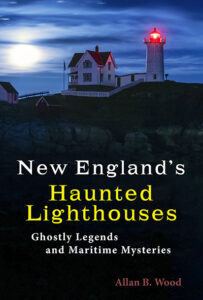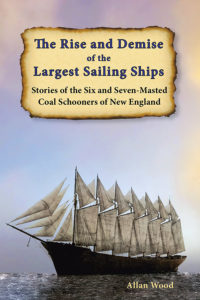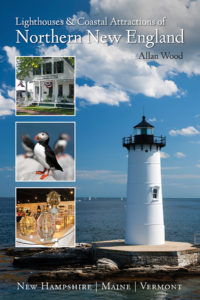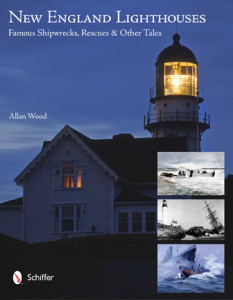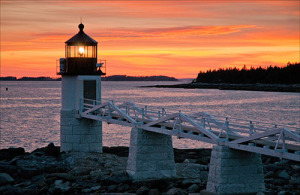Bohemian Wreck Mural at South Portland Post Office in Maine
The Bohemian Shipwreck
Near Cape Elizabeth Twin Lights and Portland Head Lighthouse
On February 4, 1864, the steamer Bohemian was making a winter voyage leaving Liverpool, England, for Portland, Maine. The 295-foot steamer carried about 219 passengers, including 200 Irish immigrants and 19 cabin-class passengers. As was the custom in those days, immigrants would be crowded below deck at the bottom of the ship in steerage away from the other passengers. Captain Borland had his 98 crewmen aboard the vessel and was very familiar with the Portland Harbor, as he had made the journey several times during his eight years at the helm.
On February 22, 1864, on President’s Day, the Bohemian proceeded up the Maine coast towards Cape Elizabeth, moving rather slowly as a hazy sky filled the night. Sometime after 7 o’clock, the lookout notified the captain that he spotted two lights offshore. They were the Cape Elizabeth Twin Lights range lights a few miles south of Portland Head Light. Borland had miscalculated the distance from the atmospheric haze and believed he was seven or eight miles offshore. But, in reality, the Bohemian was only a couple of miles from the rocky shoreline and proceeding dangerously close to Alden’s Rock. This was a treacherous ledge in shallow water that, at the time, was only marked by a silent buoy, not a bell buoy. Borland could not see Portland Head Lighthouse from his position.
By 8 o’clock, the first officer had just taken the wheel when a buoy marking the perilous rock was spotted directly ahead. The captain yelled to have the engines shut off to slow the vessel, but it was too late. The Bohemian struck Alden’s Rock, ripping a gash in the hull. Borland tried to head the vessel toward shore, eventually reaching an inlet location about two miles from the mainland. Still, the disabled steamer could not proceed any further under power due to the water she had taken in and the damage inside the engine room. The steamer could only drift towards shore. The captain ordered the gunboats to fire to signal the Bohemian’s distress, but only one could be set off as the other was already underwater. A pilot boat’s captain was in the vicinity a mile away and heard the one gun but believed the ship was celebrating President’s Day.
To keep the Bohemian from drifting back out to sea, anchors were dropped, and the captain ordered the lifeboats deployed immediately. While most lifeboats could launch safely, a support pin in the second lifeboat gave way, spilling 40 passengers into the freezing waters and drowning 16 of them. As the lifeboat drifted ashore near Cape Elizabeth hours later, locals found only one man and child, both dead.
Most boats launched in the hysteria were not filled and contained primarily men. The frightened passengers and crew aboard the lifeboats refused to return to the sinking ship to pick up those stranded on the deck for fear of capsizing. Some of those stranded on the wreck jumped into the icy waters in hopes of being hauled into the boats, but many drowned from exposure in their struggles.
With the lifeboats dispatched, Captain Borland, four of his crew, and around seventy passengers found themselves stranded on deck. With the steamer’s bridge completely covered in water and the seas constantly sweeping over her, Captain Borland knew the Bohemian’s ability to remain afloat was getting shorter. The steamer was less than 1000 feet from shore when some lifeboats returned to pick up survivors. Additional help was provided by residents at the Ocean House and from the Fishing House on Cape Elizabeth, who sent teams out to help the survivors and later help in the gruesome task of picking up the corpses floating in the waters and bringing them to shore.
Some of those stranded, many of whom were women and children, who were still waiting and could not climb up the masts and rigging, were being washed overboard as the ship started to sink into the icy waters. Captain Borland managed to get about fifty passengers and most of his crew off the wreck to safety. He and his remaining crew waited until all the remaining survivors were in the lifeboats before they climbed into the last lifeboat to shore. An hour and a half later, the Bohemian sank. In total, two crewmembers and a total of forty passengers, all Irish immigrants from the lower steerage class, perished. The nineteen cabin passengers survived.
The locals of Cape Elizabeth opened their homes to provide food, shelter, and clothing to the exhausted survivors. In contrast, City Hall provided temporary shelter as the survivors tried to notify their families in England and Ireland. The Portland Board of Trade collected money for clothing and distributed it to the survivors.
In his deposition, Captain Borland testified, “When we struck, I was not certain where we were.” The ship’s officers, crew, and some passengers were asked for their recollections of the night and questioned whether the captain had been drinking. Some reported feeling the captain was intoxicated, but the chief saloon steward testified that Borland was given one glass of ale that day. There was also public outcry that the captain’s crew had left so many stranded to die on the ship while he and most of his crew survived. The jury concluded that Captain Borland was in error of judgment and was responsible for the disaster. His crew did not act professionally in trying to help the passengers fill the lifeboats, thinking only of themselves. The pilot nearby, who had heard the gun signaling the Bohemian in distress, was also ruled at fault for not investigating. They also ruled that Alden’s Rock should have had a bell buoy instead of a silent buoy to warn vessels passing by the treacherous rock.
Days later, some women from nearby Cape Elizabeth found items from the Bohemian wreck, including bolts of wool, silks, and satins, which many used to create new clothing for the harsh winter.
After the Bohemian’s shipwreck and public outcry, the Portland Board of Trade investigated the rocks and shoals nearby and placed bell buoy markers as needed. Portland Head Lighthouse’s visibility was also examined and improved by raising the tower 20 feet in 1865. A second-order Fresnel lens was also installed to generate a more powerful light.
Exploring the Cape Elizabeth Twin Lights Area
For the lighthouse historians, inside the lobby of the South Portland Post Office is a mural painting of the wreck of the R.M.S. Bohemian (top image). It is worth observing as it represents one of Maine’s worst disasters, and realizing the area is much safer for travel. At least 12 of the 42 lost lives are also remembered in a small monument at Calvary Cemetery in South Portland.
Cape Elizabeth is a rocky scenic area where visitors can view both Cape Elizabeth range lights (one in the photo is the active front range light) in a nearby residential area off Route 77 at the end of Two Lights Road near Twin Lights Park. There is also a snack shack next to a nearby small beach. For those who want to explore, visitors will find Two Lights State Park just before visiting the lighthouses. Be wary that both lighthouses are private residences, but tourists can take photographs from the street.
Here are a few photos of Cape Elizabeth Lighthouse
Enjoy!
Allan Wood
Books to Explore
New England’s Haunted Lighthouses:
Ghostly Legends and Maritime Mysteries
Discover the mysteries of the haunted lighthouses of New England! Uncover ghostly tales of lingering keepers, victims of misfortune or local shipwrecks, lost souls, ghost ships, and more. Many of these accounts begin with actual historical events that later lead to unexplained incidents.
This story is included in this book as there are reports of cries at night near where the ship sank, with so many lives lost. Immerse yourself in the tales associated with these iconic beacons!
The Rise and Demise of the Largest Sailing Ships:
Stories of the Six and Seven-Masted Coal Schooners of New England.
In the early 1900s, New England shipbuilders constructed the world’s largest sailing ships amid social and political reforms. These giants were the ten original six-masted coal schooners and one colossal seven-masted vessel, built to carry massive quantities of coal and building supplies and measured longer than a football field! This self-published book, balanced with plenty of color and vintage images, showcases the historical accounts that followed these mighty ships.
Available also from bookstores in paperback, hardcover, and as an eBook for all devices.

Book – Lighthouses and Coastal Attractions in Southern New England: Connecticut, Rhode Island, Massachusetts
Lighthouses and Coastal Attractions of Southern New England:
Connecticut, Rhode Island, and Massachusetts.
This 300-page book provides memorable human interest stories from each of the 92 lighthouses. You can explore plenty of indoor and outdoor coastal attractions, including whale-watching excursions, lighthouse tours, windjammer sailing tours, parks, museums, and even lighthouses where you can stay overnight. You’ll also find plenty of stories of hauntings around lighthouses.
Lighthouses and Coastal Attractions of Northern New England:
New Hampshire, Maine, and Vermont.
This 300-page book provides memorable human interest stories from each of the 76 lighthouses like the wreck of the Bohemian in Maine. It also describes and provides contact info for plenty of indoor and outdoor coastal attractions and tours. These include whale watching, lighthouse tours, unique parks, museums, and lighthouses where you can stay overnight. There are also stories of haunted lighthouses in these regions.
New England Lighthouses: Famous Shipwrecks, Rescues & Other Tales contains over 40 stories, including the wreck of the Bohemian in southern Maine. This image-rich book also contains vintage images provided by the Coast Guard and various organizations and paintings by six famous Coast Guard artists.
You can purchase this book and the lighthouse tourism books from the publisher Schiffer Books or in many fine bookstores such as Barnes and Noble.
Copyright © Allan Wood Photography; do not reproduce without permission. All rights reserved.
Join, Learn, and Support The American Lighthouse Foundation

